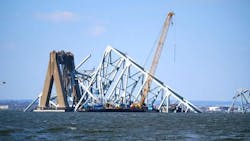Crews Work to Open Port Baltimore
Crews are removing the first layers of the Francis Scott Key Bridge wreckage, with the goal of opening a temporary channel for vessels to pass through the vital port.
Clearing the channel also will allow the search for the missing victims to continue, authorities said in a statement Saturday. In the meantime, conditions in the water make it unsafe for divers as pieces of the bridge remain submerged in the water.
“At this time, pieces of the bridge trusses have started being cut and removed,” said Kimberly Reaves, U.S. Coast Guard spokesperson Petty Officer, in a statement. “The top part of a northern section of the bridge has been removed.”
Officials don’t yet have a timeline for reopening the channel or rebuilding the bridge, Secretary of Transportation Pete Buttigieg said Sunday on CBS’s “Face the Nation.”
Buttigieg said a 1,000-ton capacity lift crane is on site and a 600-ton crane is on its way to help remove dismantled pieces of the bridge.
“This is going to be a very complex process,” he said. “There are, even now, forces acting on that steel, so it takes a lot to make sure that it can be dismantled safely, to make sure that the vessel stays where it is supposed to be and doesn’t swing out into the channel.”
Officials at the site of the bridge collapse told CNN they are doing engineering analysis and surveys to determine how to tackle the 3,000 to 4,000 tons of mangled wreckage that extends 50 feet deep into the channel.
Removing the thousands of tons of steel and concrete resting atop the vessel’s bow will be one of the most intricate parts of the dismantling operation.
The wreckage will be lifted one piece at a time. After each lift, responders will scan and survey the area and divers will go in the water, said Estee Pinchasin, U.S. Army Corps of Engineers Commander and district engineer, in a statement to CNN.
“We are not just looking at how we’re going to engineer this,” Pinchasin said. “We’re scanning to make sure that if we identify any vehicles or any of the fallen, that we are able to react.”
Divers from the Maryland State Police are on a “hot standby,” Pinchasin added, ready to handle any recovery quickly.
The work will allow for the opening of a temporary restricted channel for vessels to move into the area and assist with recovery, Maryland Gov. Wes Moore said Saturday.
The temporary channel will allow commercially essential vessels to access the port and “mark an important first step along the road to reopening the port of Baltimore,” said Capt. David O’Connell, federal on-scene coordinator for the bridge collapse response, in a statement.
Rebuilding the bridge will take longer, Buttigieg said Sunday.
“I can tell you the original bridge took about five years to build, but that doesn’t necessarily inform us about the timeline on the reconstruction,” he said. “We don’t fully know everything we need to know about the condition of the portions of the bridge that did not collapse.”
The work is currently being funded through $60 million in emergency relief funds through the U.S. Department of Transportation (USDOT), Buttigieg said, adding officials may need to turn to Congress to supplement the funding.
To reopen the port, the Coast Guard says it will first clear debris from the deep draft channel, remove the ship, then clear debris from the bridge across the waterway
Divers could face uncertain conditions when they return to the water.
Diving operations were paused for the four missing victims because vehicles were found encased in concrete and other debris, making it unsafe for divers, Col. Roland L. Butler said last week.
After search efforts were halted, remote vehicles were sent down with sonar that plotted what exactly fell deep into the Patapsco River after the collapse, Butler said in a statement. Drones and infrared technology were also used as part of the search.
Once salvage operations clear the debris, divers resuming the search for the victims could be faced with a difficult task, according to Mark Martin of marine survey and salvage company at SalvOcean LLC.
“The current there is quite fast and having spent a number of days submerged in Baltimore Harbor, I can tell you that you can never see more than one or two feet in front of your face,” Martin told CNN Saturday.
Still, the current isn’t heavy enough to shift larger pieces of debris, Martin said.
“Once those things start getting cut up, then you have to be careful, you’re going to have to monitor the current, the direction, the speed, all of those things,” he said.
----------------------------
Source: CNN
